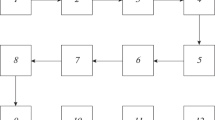Abstract
THE ordering of matter in amorphous materials can be characterized by a radial distribution function of density 4πr2ρ(r), and a difference radial distribution function 4πr2(ρ(r) − ρ0). The latter is obtained1 from experimental scattering data I(s) by the Fourier inversion:  where s = 2sin½β/λ, β is the scattering angle, and f is the atomic scattering factor. f is a smoothly decreasing function of s and the quantity to be inverted is the ratio of the ripple of I(s) about f2(s), to the smooth curve f2(s).
where s = 2sin½β/λ, β is the scattering angle, and f is the atomic scattering factor. f is a smoothly decreasing function of s and the quantity to be inverted is the ratio of the ripple of I(s) about f2(s), to the smooth curve f2(s).
Similar content being viewed by others
References
For example, Guinier, A., X-Ray Diffraction in Crystals, Imperfect Crystals and Amorphous Bodies (Freeman, London, 1963).
Grigson, C. W. B., J. Electronics and Control, 12, 209 (1962).
Denbigh, P. N., and Grigson, C. W. B., J. Sci. Inst., 42, 305 (1965).
Tompsett, M. F., and Grigson, C. W. B., Nature, 206, 923 (1965).
Author information
Authors and Affiliations
Rights and permissions
About this article
Cite this article
GRIGSON, C., TOMPSETT, M. Determination of Radial Distribution Functions by Elastic Electron Diffraction. Nature 210, 86–87 (1966). https://doi.org/10.1038/210086a0
Issue Date:
DOI: https://doi.org/10.1038/210086a0
- Springer Nature Limited
This article is cited by
-
Exploring the differences and similarities between urea and thermally driven denaturation of bovine serum albumin: intermolecular forces and solvation preferences
Journal of Molecular Modeling (2018)
-
Participation of π-Electrons of Phospholipid Molecules in Absorption of Ultraviolet Light in the Range of 260–280 nm
Journal of Evolutionary Biochemistry and Physiology (2005)
-
Review: Scanning high-energy electron diffraction (SHEED) in materials science
Journal of Materials Science (1972)





